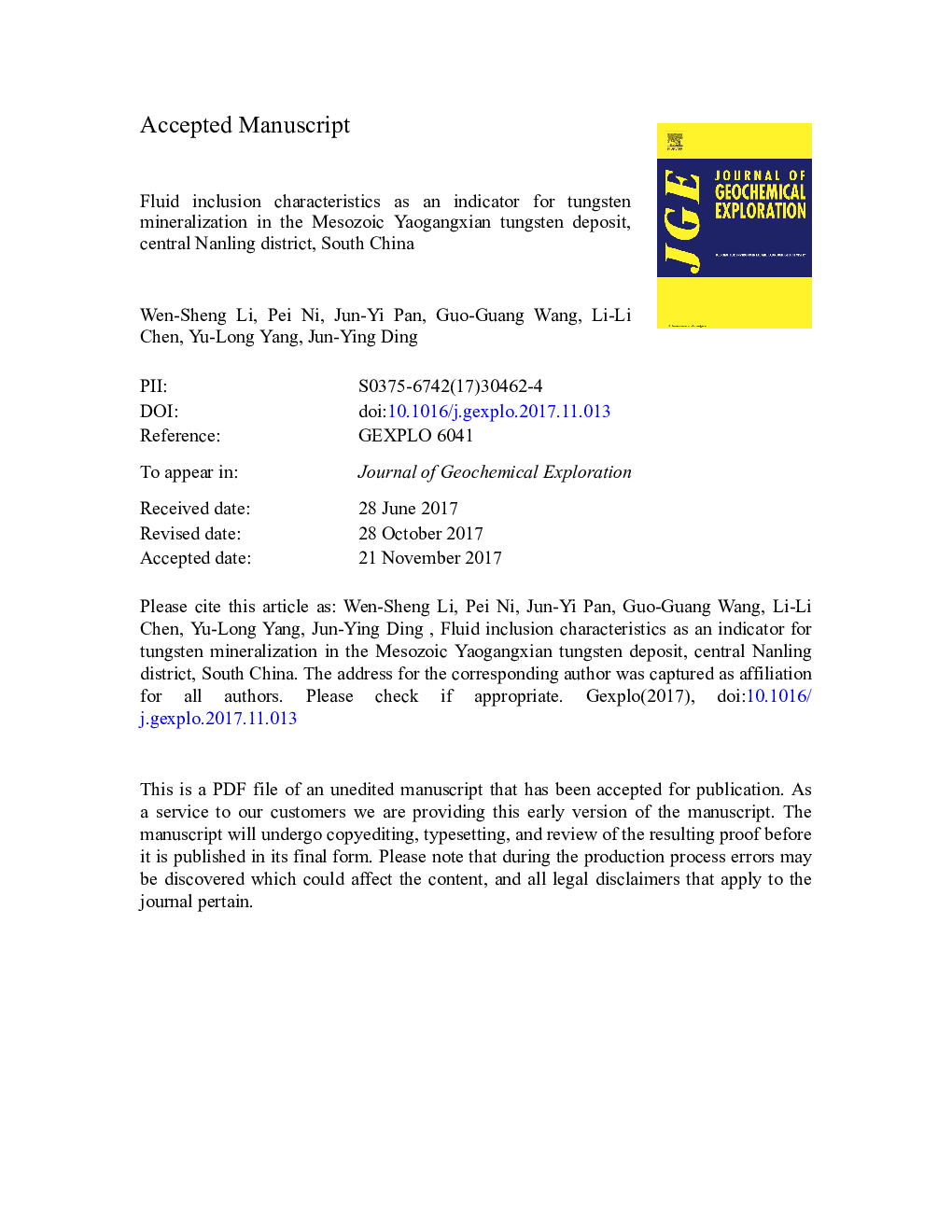| کد مقاله | کد نشریه | سال انتشار | مقاله انگلیسی | نسخه تمام متن |
|---|---|---|---|---|
| 8865847 | 1620865 | 2018 | 61 صفحه PDF | دانلود رایگان |
عنوان انگلیسی مقاله ISI
Fluid inclusion characteristics as an indicator for tungsten mineralization in the Mesozoic Yaogangxian tungsten deposit, central Nanling district, South China
دانلود مقاله + سفارش ترجمه
دانلود مقاله ISI انگلیسی
رایگان برای ایرانیان
موضوعات مرتبط
مهندسی و علوم پایه
علوم زمین و سیارات
زمین شناسی اقتصادی
پیش نمایش صفحه اول مقاله

چکیده انگلیسی
The giant Yaogangxian tungsten deposit, situated in the central Nanling region of South China, is one of the largest tungsten deposits in China. It comprises both large-scale wolframite-quartz vein-type and scheelite-skarn mineralization. The wolframite-quartz vein-type mineralization can be divided into three successive hydrothermal vein-forming stages, based on mineral paragenesis and crosscutting relationships: stage 1 (early) wolframite-cassiterite-quartz veins, also termed “main-stage” veins, characterized by significant wolframite deposition; stage 2 sulfide-quartz veins, where abundant sulfide minerals were introduced during vein formation; and stage 3 fluorite-carbonate-quartz veins that resulted from the latest hydrothermal event and commonly crosscut earlier veins. Fluid inclusion petrographic, microthermometric and Raman spectroscopic analyses were carried out on wolframite, quartz and fluorite. Three types of fluid inclusions were recognized in wolframite, quartz and fluorite: two-phase liquid-rich (type L), two-phase CO2-bearing (type CB), and CO2-rich fluid inclusions (type C). Secondary type L fluid inclusions were also recorded in wolframite. In main-stage veins, primary type L and CB inclusions occur in both wolframite and quartz crystals, whereas type C only occurs in quartz and coexists with type L. Type L and CB inclusions in wolframite exhibit homogenization temperatures of 280 to 360 °C and 321 to 355 °C, with salinities of 2.2 to 7.6 and 2.8 to 3.6 wt% NaCl equivalent (NaCl equiv.), respectively. Secondary type L inclusions in wolframite have homogenization temperatures of 204 to 256 °C, with salinities of 1.4 to 5.7 wt% (NaCl equiv.), which similar to type L inclusions in quartz coexisting with sulfides, indicating that the sulfide-forming fluid is preserved as secondary inclusions in wolframite. Coexisting type L and C inclusions in quartz display similar homogenization temperature ranges (244 to 317 °C) but contrasting salinity ranges of 4.2 to 7.3 and 0.2 to 2.8 wt% NaCl equiv., respectively, suggesting fluid immiscibility during stage 1 quartz formation. In stage 2 veins, type L inclusions in quartz that coexists with sulfides have lower homogenization temperatures (219 to 276 °C) and salinities (2.1 to 5.7 wt% NaCl equiv.). Type L inclusions in fluorite from stage 3 veins show the lowest homogenization temperatures (183 to 205 °C) and salinities (1.1 to 3.0 wt% NaCl equiv.). The significantly higher homogenization temperatures of fluid inclusions in wolframite than in coexisting quartz, and their observed paragenesis, indicates that wolframite was precipitated earlier than most of the coexisting quartz. H-O isotopic data, the presence of primary CO2-bearing inclusions in wolframite, and the temperature vs. salinity trends of fluid-inclusion data indicate that wolframite was most likely deposited during cooling from an initial CO2-bearing magmatic fluid; while subsequent fluid immiscibility and mixing resulted in massive quartz precipitation and sulfide mineralization. Combining the spatial distribution characteristics of vein mineralization, our study results provide new guide lines for mineral exploration. The veins containing fluid inclusions that are characterized by high homogenization temperatures and high salinities are dominated by magmatic water. Therefore in the areas where abundant sulfides and carbonates occur, the potential for tungsten-rich ore-veins is in the deeper part of the deposit.
ناشر
Database: Elsevier - ScienceDirect (ساینس دایرکت)
Journal: Journal of Geochemical Exploration - Volume 192, September 2018, Pages 1-17
Journal: Journal of Geochemical Exploration - Volume 192, September 2018, Pages 1-17
نویسندگان
Wen-Sheng Li, Pei Ni, Jun-Yi Pan, Guo-Guang Wang, Li-Li Chen, Yu-Long Yang, Jun-Ying Ding,